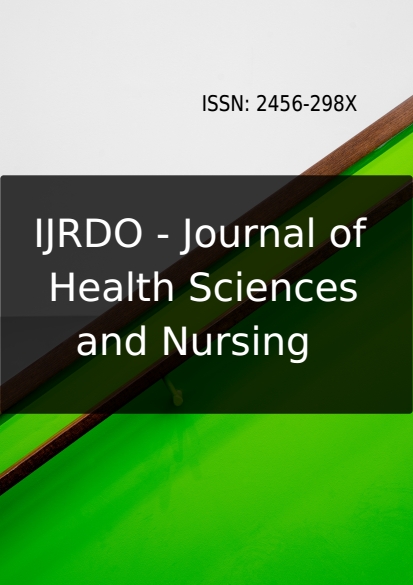NEONATAL CARE RESOURCES AND SERVICES BY NURSES IN SELECTED TERTIARY HEALTH INSTITUTIONS IN SOUTH EASTERN NIGERIA
Abstract
Neonatal developmental stage is a critical period, and therefore requires adequate uncompromised equipment as well as competent professionals in the care of the newborn. This study focused on neonatal care resources, and services by nurses in tertiary health institutions in South Eastern Nigeria. It was a descriptive cross-sectional research design, Multistage sampling technique was used in selecting 440 respondents. Two research questions and two null hypotheses guided the study. Questionnaires on neonatal care services by nurses in Tertiary health Institutions and checklist on assessment of available and functional equipment, drugs and nursing staff strength in tertiary health institutions were the instruments used for data collection in the study. Standard descriptive statistics of frequency distribution , means and standard deviation (SD) were used to summarize the variables. Mean scores and percentages were used to answer the research questions while Mann-Whitney U and Kruskal Wallis tests were adopted in testing the null hypotheses at 0.05 level of significance. The results revealed availability of essential equipment for neonatal care in the tertiary health institutions as recommended by WHO, and gender of nurses had no significant influence on the quality of neonatal care given by nurses (ⱬ score = 0.40; p-value = 0.69). In addition, years of working experience of nurses was found to have significance influence on the quality of neonatal care given by nurses (x2 =25.63; p-value = 0.00).
Downloads
References
American Academy of Pediatrics. (2012). Levels of Neonatal Care. Retrieved on 28th October 2015 from http://pediatrics.appublications.org/content/130/3/587.full.html
Atasay B, Arsan S. (2005). Organization of Neonatal Care Services and its Importance. Journal of Perinal Medicine, 31(5), 392-394.
Bliss. (2012). Bliss Baby Charter Audit Tool. London: Bliss.
British Association of Perinatal Medicine (2010). Standards for Hospital Providing Neonatal Care. London: BAPM.
Council of International Neonatal Nurses. (2009).Frequently asked Questions. Retrieved on 28th October 2015 from http://www.cionurses.org/faqs.html.
Dorsten – Brooks F. (2013). Kangaroo Care: Skin-to-skin contact in the NICU. American Journal of Maternal Child Nursing,18(5): 250-253.
Douglas H. (2010).Neonatal Care. Retrieved on 28th October 2015 from http://www.etymonline.com/index.php?tearn=neonatal.
Federal Ministry of Health Nigeria. (2009). Situation Analysis and Action plan for Newborn Health. Retrieved on 28th October 2016 from http://www.savethechildren.org/publication/newbornsreport.pdf.
George I, Ugboma A & Nyengidiki T. (2012). Newborn Care in the Delivery Room: An Observational Study from Nigeria. International Journal of Tropical Medicine, 7(1), 30-33.
Hamilton K, Redshew M, Tarnow-Mordi W. (2007). Nurse Staffing in Relation to Risk-Adjusted Mortality in Neonatal Care. Achieves of Disease in Childhood-Fetal and Neonatal Edition,6 92, 99-103.
Linda V, Alexander M, Terhi J, Sabine G, Eunice O, Augustinus H, Zelee H, Charlotte O, Betty K. (2013). Quality of Newborn Care: A Health Facility Assessment in Rural Ghana. BMJ Open, 3, 23-26.
Martin S, Duke T& Matai S.(2014). Improving pediatric and neonatal care in rural district hospitals in the highlands of Papua New Guinea: a quality improvement approach. Paediatrics and International Child Health, http://dx.doi.org/10.1179%2F2046905513Y.0000000081.
Pohl J, Raseh R.(2010). Neonatal Nursing. Retrieved on 28th October 2016 from http://www.nursesource.org/neonatal.html
Selga A, Anna M. (2007). Hospital Length of Stay and Readmission Rates for Normal Deliveries: A Controlled Evaluation. Retrieved on 28th October 2015 from http://www.doh.gov.ph/itrmc/hospital-length-of-stay.html
United Nations Children’s Fund (2015). Recommended Equipment and Drugs for Newborn Care According to Service Delivery Level. Retrieved on 28th October 2015 from http://www.snl/childinfo.org/file/child.
Vericourt F. (2008). Nurse - to - Patient Ratios in Hospitals: A Queuing Perspective. International Nursing Review. Retrieved on 28th October 2017 from http://en.wikipedia.org/wiki/nursing
Victor I, Person J. (2004). Implementation of Kangaroo Care: a Parent health care team approach to practice change. Critical Care Nursing Clinics of North America, 6(4): 891-895.
Vincent L. (2008). Nurse Staffing and Patient. Retrieved on 28th October 2017 from http://gorefest.blogspot.com
World Health Organization (2015). Recommended Equipment and Drugs for Newborn Care According to Service Delivery Level. Retrieved on 28th October 2015 from http://www.snl/childinfo.org/file/child.
World Health Organization. (2010). Standard and Quality of Neonatal Care. Retrieved on 28th October 2015 from http://www.who.who.info.child/guidelines.recommendations.newbornhealth.pdf.
Copyright (c) 2020 IJRDO - Journal of Health Sciences and Nursing (ISSN: 2456-298X)

This work is licensed under a Creative Commons Attribution-NonCommercial-NoDerivatives 4.0 International License.
Author(s) and co-author(s) jointly and severally represent and warrant that the Article is original with the author(s) and does not infringe any copyright or violate any other right of any third parties, and that the Article has not been published elsewhere. Author(s) agree to the terms that the IJRDO Journal will have the full right to remove the published article on any misconduct found in the published article.



